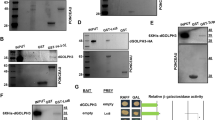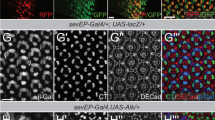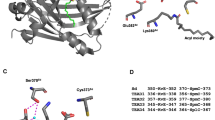Abstract
Originally identified in Drosophila melanogaster, the Warts(Wts)/Lats protein kinase has been proposed to function with two other Drosophila proteins, Hippo (Hpo) and Salvador (Sav), in the regulation of cell cycle exit and apoptosis. In mammals, two candidate Warts/Lats homologs, termed Lats1 and Lats2, have been described, and the targeted disruption of LATS1 in mice increases tumor formation. Little, however, is known about the function and regulation of human Lats kinases. Here we report that human Mst2, a STE20-family member and purported Hpo ortholog, phosphorylates and activates both Lats1 and Lats2. Deletion analysis revealed that regulation of Lats1 occurs through the C-terminal, catalytic domain. Within this domain, two regulatory phosphorylation sites were identified by mass spectrometry. These sites, S909 in the activation loop and T1079 within a hydrophobic motif, have been highly conserved during evolution. Moreover, a direct interaction was observed between Mst2 and hWW45, a putative ortholog of Drosophila Sav. These results indicate that Mst2-like kinases regulate Lats kinase activities in an evolutionarily conserved regulatory pathway. Although the function of this pathway remains poorly understood in mammals, it is intriguing that, in Drosophila, it has been linked to development and tissue homeostasis.
This is a preview of subscription content, access via your institution
Access options
Subscribe to this journal
Receive 50 print issues and online access
$259.00 per year
only $5.18 per issue
Buy this article
- Purchase on Springer Link
- Instant access to full article PDF
Prices may be subject to local taxes which are calculated during checkout









Similar content being viewed by others
References
Buchberger A . (2002). Trends Cell Biol., 12, 216–221.
Cohen P, Holmes CF and Tsukitani Y . (1990). Trends Biochem. Sci., 15, 98–102.
Dammann R, Li C, Yoon JH, Chin PL, Bates S and Pfeifer GP . (2000). Nat. Genet., 25, 315–319.
Gobom J, Nordhoff E, Mirgorodskaya E, Ekman R and Roepstorff P . (1999). J. Mass Spectrom., 34, 105–116.
Graves JD, Gotoh Y, Draves KE, Ambrose D, Han DK, Wright M, Chernoff J, Clark EA and Krebs EG . (1998). EMBO J., 17, 2224–2234.
Harvey KF, Pfleger CM and Hariharan IK . (2003). Cell, 114, 457–467.
Hisaoka M, Tanaka A and Hashimoto H . (2002). Lab. Invest., 82, 1427–1435.
Hoffmann R, Metzger S, Spengler B and Otvos Jr L . (1999). J. Mass Spectrom., 34, 1195–1204.
Hori T, Takaori-Kondo A, Kamikubo Y and Uchiyama T . (2000). Oncogene, 19, 3101–3109.
James P, Halladay J and Craig EA . (1996). Genetics, 144, 1425–1436.
Jia J, Zhang W, Wang B, Trinko R and Jiang J . (2003). Genes Dev., 17, 2514–2519.
Johnson LN, Noble ME and Owen DJ . (1996). Cell, 85, 149–158.
Justice RW, Zilian O, Woods DF, Noll M and Bryant PJ . (1995). Genes Dev., 9, 534–546.
Kango-Singh M, Nolo R, Tao C, Verstreken P, Hiesinger PR, Bellen HJ and Halder G . (2002). Development, 129, 5719–5730.
Khokhlatchev A, Rabizadeh S, Xavier R, Nedwidek M, Chen T, Zhang XF, Seed B and Avruch J . (2002). Curr. Biol., 12, 253–265.
Lee KK, Ohyama T, Yajima N, Tsubuki S and Yonehara S . (2001). J. Biol. Chem., 276, 19276–19285.
Lee KK and Yonehara S . (2002). J. Biol. Chem., 277, 12351–12358.
Li Y, Pei J, Xia H, Ke H, Wang H and Tao W . (2003). Oncogene, 22, 4398–4405.
Millward TA, Hess D and Hemmings BA . (1999). J. Biol. Chem., 274, 33847–33850.
Morisaki T, Hirota T, Iida S, Marumoto T, Hara T, Nishiyama Y, Kawasuzi M, Hiraoka T, Mimori T, Araki N, Izawa I, Inagaki M and Saya H . (2002). FEBS Lett., 529, 319–324.
Nishiyama Y, Hirota T, Morisaki T, Hara T, Marumoto T, Iida S, Makino K, Yamamoto H, Hiraoka T, Kitamura N and Saya H . (1999). FEBS Lett., 459, 159–165.
Pantalacci S, Tapon N and Leopold P . (2003). Nat. Cell Biol., 5, 921–927.
Praskova M, Khoklatchev A, Ortiz-Vega S and Avruch J . (2004). Biochem. J., 381, 453–462.
Preisinger C, Short B, De CV, Bruyneel E, Haas A, Kopajtich R, Gettemans J and Barr FA . (2004). J. Cell Biol., 164, 1009–1020.
Scheel H and Hofmann K . (2003). Curr. Biol., 13, R899–R900.
Seelos C . (1997). Anal. Biochem., 245, 109–111.
Shevchenko A, Wilm M, Vorm O and Mann M . (1996). Anal. Chem., 68, 850–858.
Sillje HHW, Takahashi K, Tanaka K, Van Houwe G and Nigg EA . (1999). EMBO J., 18, 5691–5702.
Song MS, Song SJ, Ayad NG, Chang JS, Lee JH, Hong HK, Lee H, Choi N, Kim J, Kim H, Kim JW, Choi EJ, Kirschner MW and Lim DS . (2004). Nat. Cell Biol., 6, 129–137.
St John MA, Tao W, Fei X, Fukumoto R, Carcangiu ML, Brownstein DG, Parlow AF, McGrath J and Xu T . (1999). Nat. Genet., 21, 182–186.
Tamaskovic R, Bichsel SJ and Hemmings BA . (2003). FEBS Lett., 546, 73–80.
Tao W, Zhang S, Turenchalk GS, Stewart RA, St John MA, Chen W and Xu T . (1999). Nat. Genet., 21, 177–181.
Tapon N, Harvey KF, Bell DW, Wahrer DC, Schiripo TA, Haber DA and Hariharan IK . (2002). Cell, 110, 467–478.
Taylor LK, Wang HC and Erikson RL . (1996). Proc. Natl. Acad. Sci. USA, 93, 10099–10104.
Toji S, Yabuta N, Hosomi T, Nishihara S, Kobayashi T, Suzuki S, Tamai K and Nojima H . (2004). Genes Cells, 9, 383–397.
Udan RS, Kango-Singh M, Nolo R, Tao C and Halder G . (2003). Nat. Cell Biol., 5, 914–920.
Valverde P . (2000). Biochem. Biophys. Res. Commun., 276, 990–998.
Wu S, Huang J, Dong J and Pan D . (2003). Cell, 114, 445–456.
Xu T, Wang W, Zhang S, Stewart RA and Yu W . (1995). Development, 121, 1053–1063.
Yabuta N, Fujii T, Copeland NG, Gilbert DJ, Jenkins NA, Nishiguchi H, Endo Y, Toji S, Tanaka H, Nishimune Y and Nojima H . (2000). Genomics, 63, 263–270.
Yang X, Li DM, Chen W and Xu T . (2001). Oncogene, 20, 6516–6523.
Yang X, Yu K, Hao Y, Li DM, Stewart R, Insogna KL and Xu T . (2004). Nat. Cell Biol, 6, 609–617.
Acknowledgements
We thank Elena Nigg and Anja Wehner for excellent technical assistance. We are also grateful to Francis Barr and Hideyuki Saya for providing plasmids and thank Roman Körner for his help and advice in MS analysis. This work was supported by the Max-Planck Institute. Eunice HY Chan is a scholarship holder of the Hong Kong Croucher Foundation.
Author information
Authors and Affiliations
Corresponding author
Rights and permissions
About this article
Cite this article
Chan, E., Nousiainen, M., Chalamalasetty, R. et al. The Ste20-like kinase Mst2 activates the human large tumor suppressor kinase Lats1. Oncogene 24, 2076–2086 (2005). https://doi.org/10.1038/sj.onc.1208445
Received:
Revised:
Accepted:
Published:
Issue Date:
DOI: https://doi.org/10.1038/sj.onc.1208445
Keywords
This article is cited by
-
Inhibition of LATS kinases reduces tumorigenicity and increases the sensitivity of human chronic myelogenous leukemia cells to imatinib
Scientific Reports (2024)
-
The LKB1–TSSK1B axis controls YAP phosphorylation to regulate the Hippo–YAP pathway
Cell Death & Disease (2024)
-
PPP1R12A is a recycling endosomal phosphatase that facilitates YAP activation
Scientific Reports (2023)
-
Sirtuin 5-mediated deacetylation of TAZ at K54 promotes melanoma development
Cellular Oncology (2023)
-
Soft substrate maintains stemness and pluripotent stem cell-like phenotype of human embryonic stem cells under defined culture conditions
Cytotechnology (2022)



